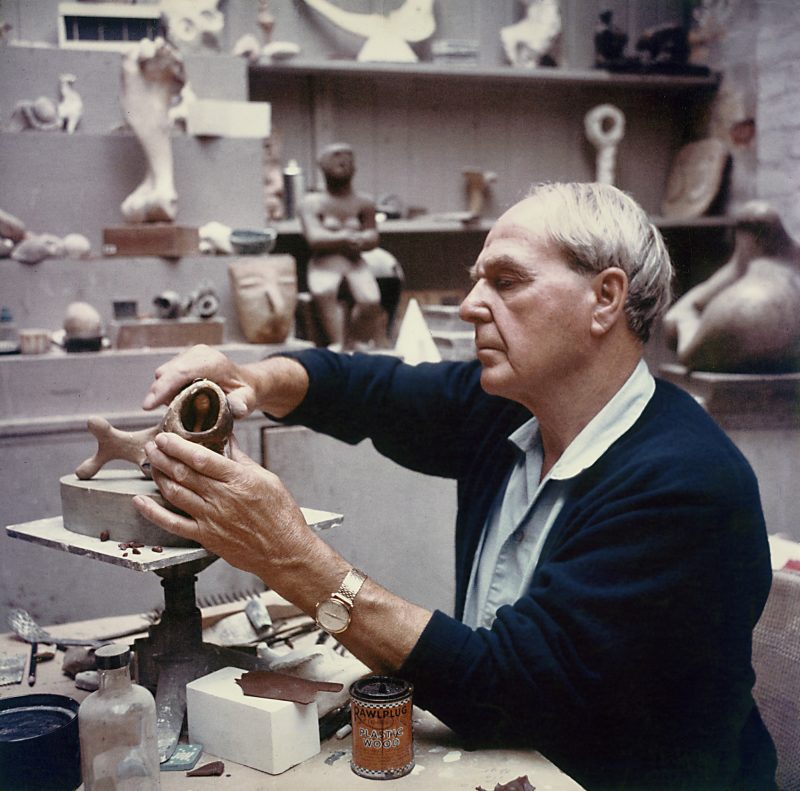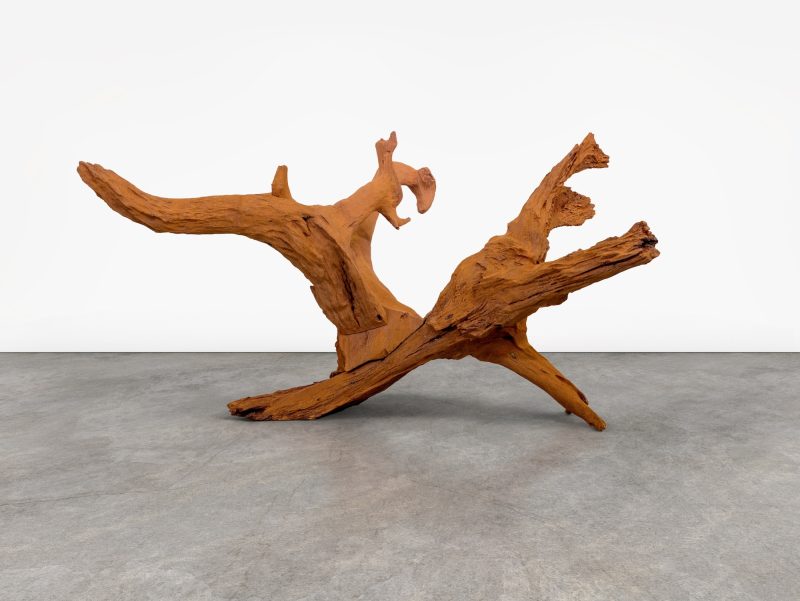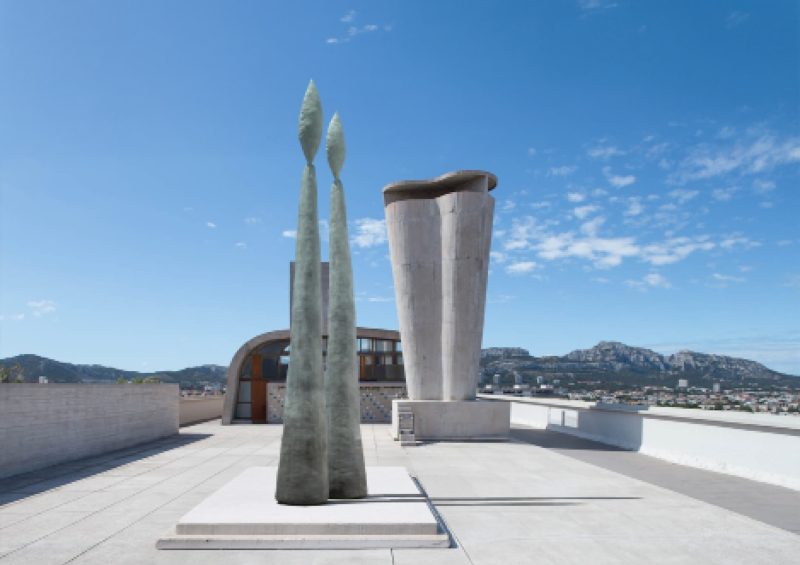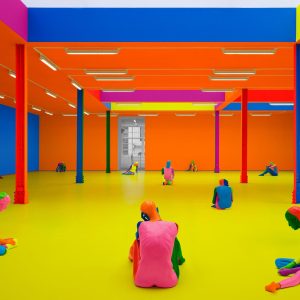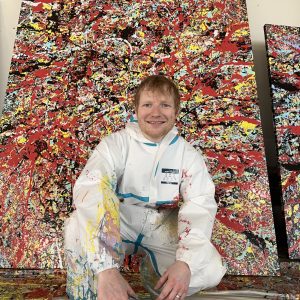The movement and sounds in Rachel Youn’s sculptures provide a sense of harmony and also unease. Youn provides personalities to their sculptures by utilizing machinery. Manipulating the programmed mechanics provides a new way to harness movements that create a visceral feeling, an energy, a vibe.

Youn is providing second life to these objects outside their intended use. The shaking, swaying, rocking of the objects is a static nature that ultimately affects the space and how a viewer will interact with it. At first glance, the sculptures can look fragile and precariously placed, perhaps even vulnerable and restricted in movement, yet the artificial elements of plastic branches, plants, and mechanics provide life and vitality.
Rachel Youn is from Albuquerque, New Mexico, and is currently living and working in New York City. Not only are the sculptures they create a source of personal contemplation of the world, but they prove to be thought experiments that allow viewers to get in touch with their own movements and assess what freedoms, allowances, and restrictions they may face within their own lives.
Youn received their BFA from the Sam Fox School of Design & Visual Arts at Washington University in St. Louis and their MFA from Yale School of Art.
Their solo and group exhibitions include the Contemporary Art Museum St. Louis; LVL3 Gallery, Chicago; Bruno David Gallery, St. Louis; Soy Capitán, Berlin, Germany; Galerie du Monde, Hong Kong; Laumeier Sculpture Park, St. Louis; La Galleria Nazionale, Rome, Italy; Sargent’s Daughters, Los Angeles; Belenius, Stockholm, Sweden; Fondazione Sandretto Re Rebaudengo, Turin, Italy; Night Gallery, Los Angeles; YveYANG Gallery, New York; Aranya Art Center, China; SOMArts Cultural Center, San Francisco; and most recently at Wave Hill, New York; Podium Gallery, Hong Kong; and Sargent’s Daughters, New York.
They will have an upcoming exhibition at Soy Capitán, Berlin, Germany; The Aldrich Contemporary Art Museum, Connecticut in Fall 2024 and at G Gallery, Seoul, South Korea, in Spring 2025.
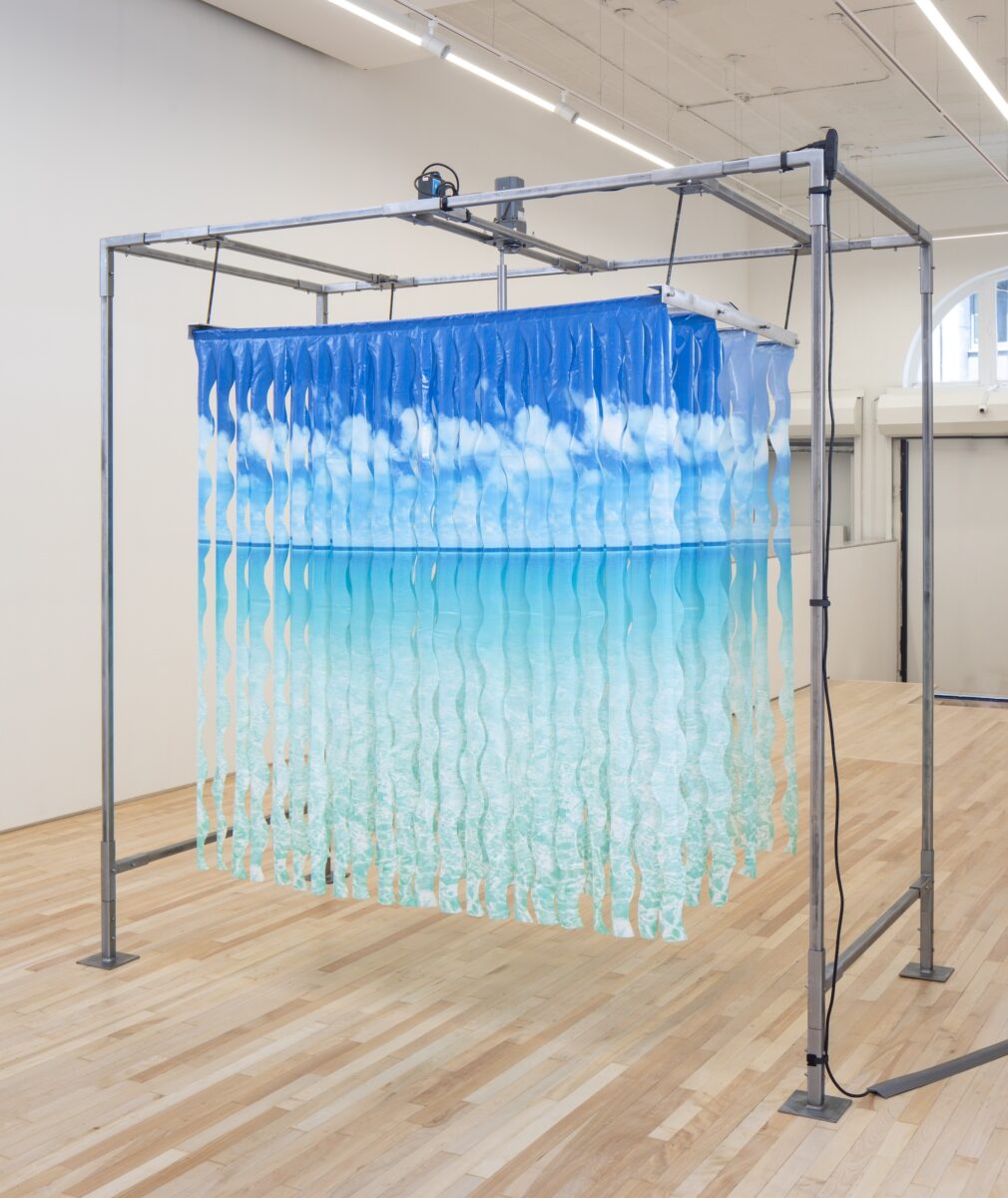
Phillip Edward Spradley: You recently completed your MFA. Can you share how you previously worked and how you perhaps rethought, reimagined, or reframed the way you have come to think about your art? Are there new ways of working, and are there old ways you have put to rest?
Rachel Youn: Like a lot of people I went to grad school to shake up the process that I’m used to which felt very formulaic. I think there are still a lot of components of the older work that I carry through new work in regard to motion and fake plants.
I always liked finding variations of movement with the massagers and the different movements the plants articulated, but I just wanted to spend more time with my practice and put things together better. For years I’ve been taking these massagers, baby swings, and other machines apart, out of this curiosity to figure out how so much of the everyday appliances and machines around us work, and grad school was the chance to really dive deep
What I found through a lot of it and through showing that work is that there’s a lifespan on them. They’re not made to be fixable. They’re made of all these plastic gears that just grind down over time. They are manufactured at mass and as cheaply as possible in a factory. In grad school I took a machining class and learned how to make hardware or make things like fit custom or even just understand more about hardware and I spent a lot of time at the hardware store to get the right stainless steel hardware that fits perfectly in a sculpture. I think I’m interested in building things out better because of this inherent disappointment and failure that’s built into these objects and I kind of like the responsibility of stewarding that. I really just wanted to spend more time with these machines and kind of play to their strengths rather than just accepting that they’re probably gonna die after a few months.
I also had the opportunity to tackle making larger work. School gave me access to a shop and welding again. We had one critique a semester. So there was a lot of time to kind of consider things like space, smell, or lighting that I hadn’t thought about for years. That’s how I created the piece that looks like a car wash. I just thought about how it feels to be swallowed up by something, and to be kind of overwhelmed by it too. I also got really interested in modularity. It turns out I’m really anal and obsessive. There was this kind of slapped together way of working before and working to put components together quickly because I just need to get it out the door versus now, I’m like, how do I ensure every little step of this process is well thought out, but also documented so I can fix or replace something if it breaks. Machines break all the time, and we take for granted that they work all the time. I have been feeling empowered to understand how things come apart, how to put it back together, how to replace things.
CLEANSE (I’ll do it myself), 2023. Steel, aluminum, AC motor, hardware, nylon, UHMW, “Escape Photoreal Ocean” PEVA shower curtains. Video: Courtesy of the artist.
Technology advances, certain objects are no longer produced, others become obsolete, parts grind down. Do you think about the longevity of your sculptures?
Yeah, totally. I mean. I have to process shame when something dies, you know. When I open a show I just have this anxious month where I’m like, they’re gonna call me and be like it’s not working, which has happened. Especially like the first time I did a big show of massagers. There were like 60 of them installed, and I’d get a text message saying, “Hey, this one’s acting weird.”
After a while, I started to accept it. I recognize a kind of weird pleasure in letting it die because it’s been running constantly, because I’m bypassing these automatic shutoff features that are supposed to help preserve it, and I’m forcing them to work overtime. And so, in a way, when they die, it’s like they’re just like, “I’m tired” and I think about breakdowns, both in the mechanical sense, but also in a psychological sense too, just the way that any of us can probably continue to work at the same thing every day until suddenly you can’t. It’s like this unknown qualitative endpoint for something.
There’s something about buying a massager and not knowing how long it’s been running. A person might have used it for like an hour, they might have used it for a few hours, they might have been using it every day. I might be getting it at the end of its life, or it might be considered almost brand new. Not knowing where it is in its own lifespan is interesting. And it’s weird that I feel like I’m now taking on this responsibility of creating a new lifespan for the work because I’m using better motors. I’m trying to build out more of the mechanisms around the motors that may solve that. It’s based on the strength of the motor, but also my ability to not strain it so much with sloppy technique or something. I just really think about our expectations that things will be constant. Those moments are interrupted by failures, by breakdowns, or by emotional episodes. It’s like there’s something human or anthropomorphic about recognizing that everything else also kind works like us.
Kinetic artists, or anybody who works with machines, and anybody who’s interested, reach out asking about motors and incorporating them into their work. I kind of have to also gauge their interest in the longevity of understanding how these things work, because usually they’re just trying to get something to move in a certain way for a project, and I’m like, ‘Do you have the knowledge and the skill set for if it fails?’ ‘Did you build it to be reversible so that you can fix it?’ Sometimes the pieces stop working and it feels like you’re trying to reanimate things to get them to keep working. I’ve laid older pieces to rest or recycled them into other parts. I feel more sympathetic to machines. I don’t know, they get tired and I’m like, dude, same.

With your current body of work, you typically source your appliances through second parties, which sometimes involves going to people’s homes. Is there conversation in the transaction state of what you will ultimately be doing with these mechanisms?
I tried. For the Contemporary Art Museum St Louis exhibition I would map out like five different houses to go or to pick up massagers. I’m not originally from St. Louis, and I feel there’s a lot of artists there who have lived there their whole lives and make their work about their experiences. I got to drive around the Great Rivers area and pick up all the stuff. That was probably the biggest effort I made to tell people, not a lot of people ask about massagers. It’s obvious to them that I’m gonna massage my feet.
The sellers often would talk about how soothing and convenient the massagers were and so I would naturally ask if it was a great machine, why were they getting rid of it? And it was always that they just didn’t use it. That’s, you know, very typical for all these appliances. I started getting questions when I got speakers for that show.I was using them as pedestals, but I was also hooking them up for the sound. You just run into like some speaker dudes, you know and they’d want to know what my setup is going to be, and I would tell them they’re going to an art museum for an exhibition and I’m putting a sculpture on top of it. I would sometimes tell them what it was going to be, but I was always very shy about it. I feel like I try to be respectful as an artist and I didn’t want to sound pretentious to be like, “I’m doing a show at the Museum, and I went to the big university and I’m making, you know, these really esoteric, weird things.” I’m always curious what happens when people who aren’t used to looking at art see my work, because they’re either entertained by it or find some emotional identification, or they think it’s the stupidest thing they’ve ever seen.
I don’t know, I like having these random conversations. Most people just like to have me leave the cash and just grab it. But I’ve also talked to some people for like half an hour, and I’d get engrossed in what they were sharing and realized I’m still on my lunch break at work and I gotta go. I’m really polite and pretty curious about who they are. It’s just midwestern chit chatting until you slap your knees and you’re like, ‘Suppose I best take off now.’ But yeah, I do enjoy talking to people about it. I hear some funny stuff every once in a while.
I definitely would go to these further cities 40 min away to these thrift stores for these conversations, so it was a great way to kind of have an excuse to get out of New Haven itself and see how beautiful Connecticut is.
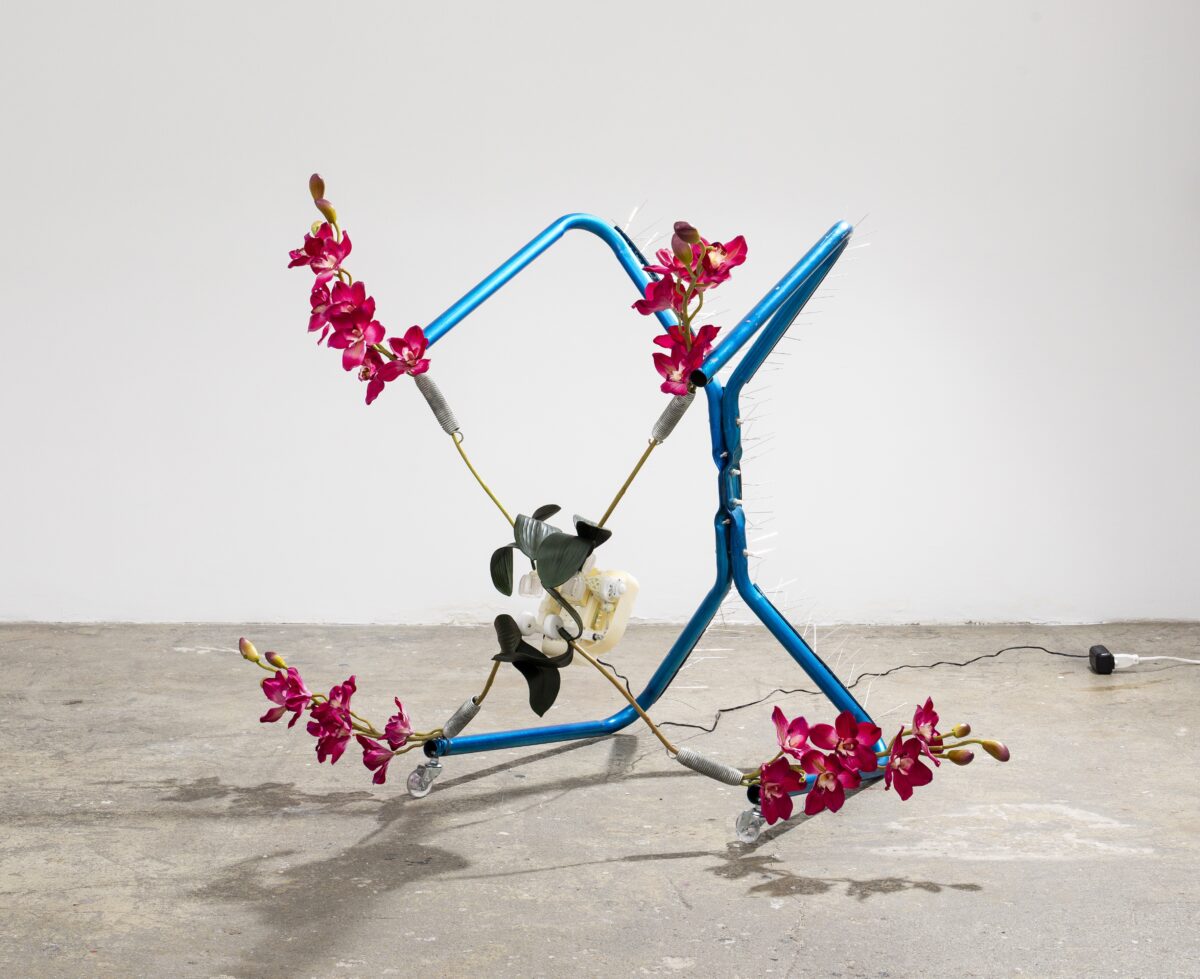

Do you seek collaboration in your work? In the past, you have commissioned a music track from a band, and a dance company provided a movement workshop that took cues from your sculptures. Are there future projects where you envision yourself working with other artists and practitioners?
For sure, I feel like it’s something I have to remind myself of, as like an artist that collaboration is a thing, also acknowledging that collaboration is actually really difficult to be 50/50 on . I would get people being like, ‘we should collaborate’, and I’m like, ‘you want me to just make this thing move’, or I tend to reduce myself to that role of I’m the technician.
I want to become more vulnerable. I think that’s also something in graduate school that was really important. I was like, oh, I’m not an island, I like the social space of working, and just seeing each other’s work in these different stages and just being vulnerable to ask for people’s opinions and help, because for the most part when I was in St. Louis, I was like the one who was working in my studio into the late hours. Sometimes I just get these weird kinds of head loops and unhinged ways of working by myself.
I don’t have any formal plans right now, but I think It also just comes with me learning to work with my control issues and like to trust people. I left St. Louis, moved to grad school and now I’m going to Berlin. You get to just meet really cool people, and I’d like to work on my attitude of seeing everyone working in their own siloed fields. There has to be some way to bridge those musicians, engineers, writers, and artists. I’ve gotten to meet so many cool people and learned so much of the crazy projects and experiences they’ve lived, and I want to find ways to work with rather than just feeling like I’m on a solo track.
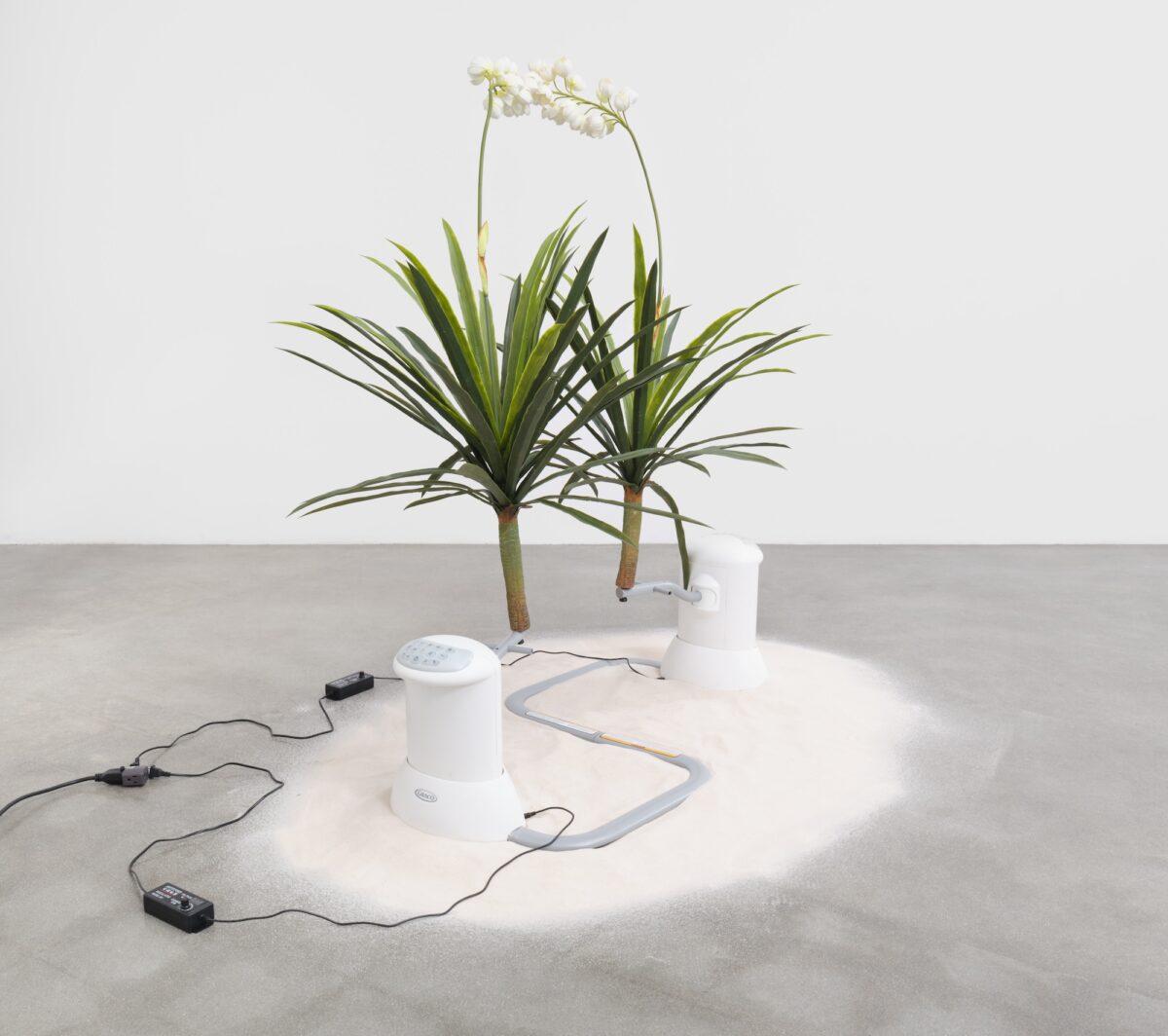
Your art is very animated, and you take humor seriously. Where do you find your comedy?
Where do I find my comedy? Contradictions. I think that’s just from a more general life stance that things are messy or I don’t want to try to compartmentalize things into good or bad. So much of life can be sad and funny at the same time. It sounds like such a basic concept, but humor is a way to make sad things relatable. I’ve been listening to this audio book about The Power of Cute by Simon May, and what’s really interesting about him talking about cute is how powerful it is because of dichotomy of helplessness and aggression, or the way that cuteness can be used to deal with national identity, like with the case of Japan after WWII.
These uncanny moments are like disruptions. With motors and machines, it’s like when something hits a bump, or it starts to grind. It’s almost like a kind of signal that something is changing or not working. I think that’s a form of comedy, or tragedy. Or somebody will be like, Oh, I ran into my ex like, isn’t that funny? It’s probably horrific, and your stomach probably dropped, but it can feel like a funny moment. Or laughing at somefucked up thing because you know how to resolve that feeling inside you, or like seeing cute things and wanting to squish it.
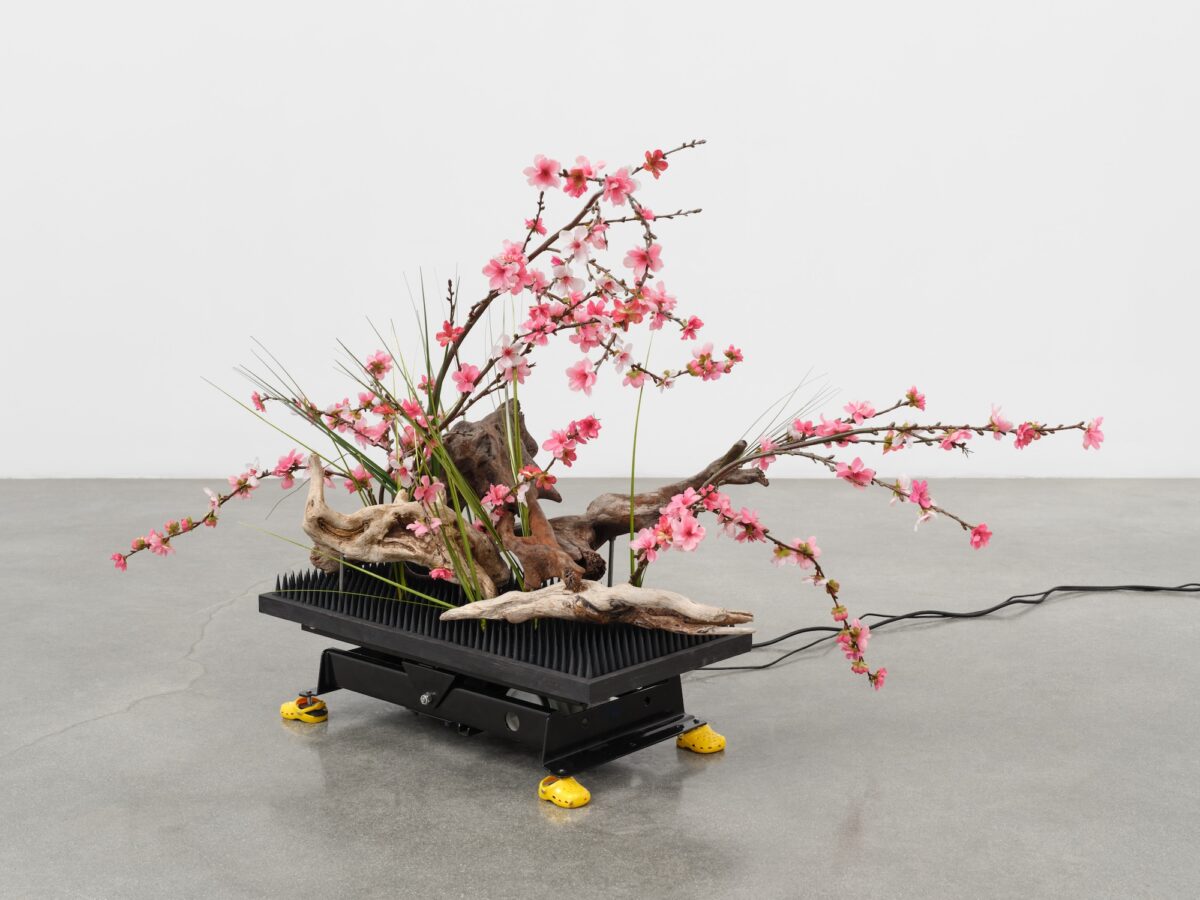
I think about the power dynamics in your sculptures. There are apparatuses that are clearly connected to these other elements, and even though they have limited mobility, they seem to have ultimate control of their wellbeing. Do you take in societal structures when thinking about the relationship between your material or even completed sculptures?
Absolutely. In a way, it’s about these machines, it’s about this technology. You know, it’s very low tech, but it’s really about the relationship of the viewer to the work, or being surrounded and immersed by the work. There’s a power in labor. There’s a power in breaking down. There’s a power in striking. When 50 massagers are running, and then, like 20 of them in a month, stop working, that creates a power structure between them and the viewers and myself. I think about object sympathy and anthropomorphizing and projecting human relationships onto things that aren’t people, because I think there’s a comedy in that, too. Like one can feel really sad for something that can’t receive emotion. I can be sad for a smushed traffic cone, but it theoretically doesn’t feel like anything.
There’s something about a product that has use-value to something that feels like it has some sort of agency both on a material/physical scale, but also philosophical scale. I think that’s cool. I might not care about something that’s been in your house for years and years and years and then, I have to donate it or throw it away right before a move. Suddenly I care, and I get sentimental.
When the work is in the gallery, they’re on the same working schedule with the employees. We turn them at the end of the day so they’re not running all night without cause, but also something bad could happen. The flowers are probably the most fickle part of the sculptures, because they’ll tangle up into each other and knock each other down if they’re in these kinds of social groups. Like at the Contemporary Art Museum St. Louis exhibition, there were so many of them, it was like a dance party and sometimes they would knock each other off their pedestals.
For the most recent work I did at Sargent’s Daughters, which resembles a car wash curtain machine, it becomes this weird confrontation space where people ask if they can walk through it. They have to either go around it or go through it and it becomes a weird social experiment that’s typical of any sort of interactive art. I decided I’m just not gonna tell anybody you can walk through it, but you can, but it is uncomfortable to try. You have to subject yourself to something new.
The most recent work could really be immersive or confrontational in space. I’m interested in the way that curators or galleries will arrange the work because they often like to separate multiple pieces. I remember the first group show I did with Sargent’s Daughters, they were clustered together and it was almost like this kind of polite gathering in the corner because they can be disruptive, like any sort of kinetic work. They take up much more space when they move, so you have to keep a wide berth around it so you don’t back up into it while you’re taking a photo of painting (I’m joking). It’s one thing to mind your body around a still sculpture, but another when that sculpture comes alive and starts reaching back at you.
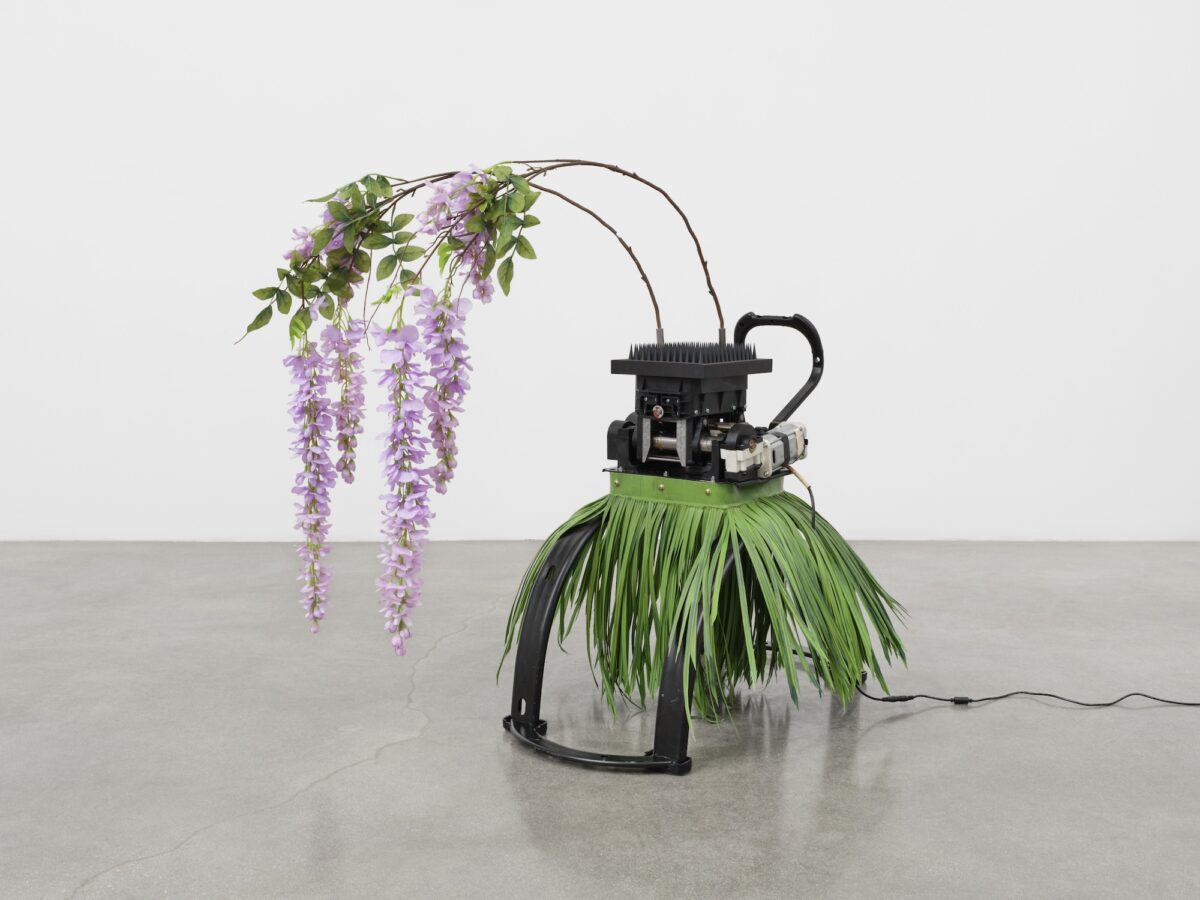
I think kinetic sculptures provide a consistent engagement that a viewer cannot attain with a still or even flat moving image. Your sculptures are embedded with energy and can provide an emotion. Have you or viewers ever discovered the pareidolia phenomenon of the tendency to find patterns in random stimuli?
Totally. I mean, I think that’s really what I was interested in with my practice even before I started doing kinetic work. I used to make these soft sculptures that look like household objects that couldn’t stand up and looked super pathetic. I think I enjoy that phenomenon, this uncanny kind of recognition of something that changes your relationship to objects. I love stuffed animals that have these very blank expressions but I also love recognizing human-like qualities in something that doesn’t have a face.. You can project a lot onto them.
I really love that people recognize personalities in their mundane surroundings. I was looking into it because there was some research about how it pops up a lot more for people on the spectrum, but also religious people too. I grew up super religious with and as a pastor’s kid, and I’ve been finding out how much it did affect my way of interacting with the world. It’s kind of like you’re looking for signs in the world. And that kind of goes back to like the uncanny and its relationship to the superstitious. I don’t know if it comes from a place of hope or dismay or loneliness.
What is it about the natural world that interests you in utilizing plants?
I’m interested in investigating the natural world, but also the fake natural world. I’m interested in the maintenance of plants, house plants, gardens, and how that requires labor and work.
It’s so important to me that the plants I use are fake, not just for material reasons. I’ve been asked if I’ve tried using real plants, which I did once and never again. The stem dried out and broke, whereas fake plants have this resiliency that allows them to be thrashed over and over. I fucking love Michael’s and Hobby Lobby. It’s a one stop shop for all the things in your house, but everything is a little fake. These fake plants are frozen in time and in a state of perfect bloom. You wouldn’t buy a fake version of a premature bloom or a dying peony, so the flowers in these stores still inherently perform perfection forever.
Nature can be beautifully chaotic and also provide patterns. Do you intentionally try to find balance and symmetry in your placement?
I tend to go towards fake exotics because it’s an extended version of the perfect bouquet you can never have because these “exotic” flowers come from all over the world. The symmetry felt natural to me and what happens when you double something. These machines usually mirror our mostly symmetric bodies. When I was making these big dance parties of these sculptures, you can read them as these doubled flowers as two arms, or two lovers, and it kind of depended on their movement. Sometimes they’d look like they were having a tender moment on the dance floor or in a physical fight. That I find to be super fascinating and I love getting people’s reads on it. I’m also interested in thinking about my work as figurative, but not representational, and leaning into the eroticism of the body.
I’m also interested in the ways we’ve developed to exercise control over nature. I think a lot about the modern lawn stemming from Victorian Gardens and this ordering of nature into these perfect little hedges you want it to look symmetrical like a fucking Wes Anderson movie. It’s weird to think about humans as extensions of nature, but also being interested in order, and like trying to figure out how we want our lives to feel ordered and geometric versus wild and chaotic.
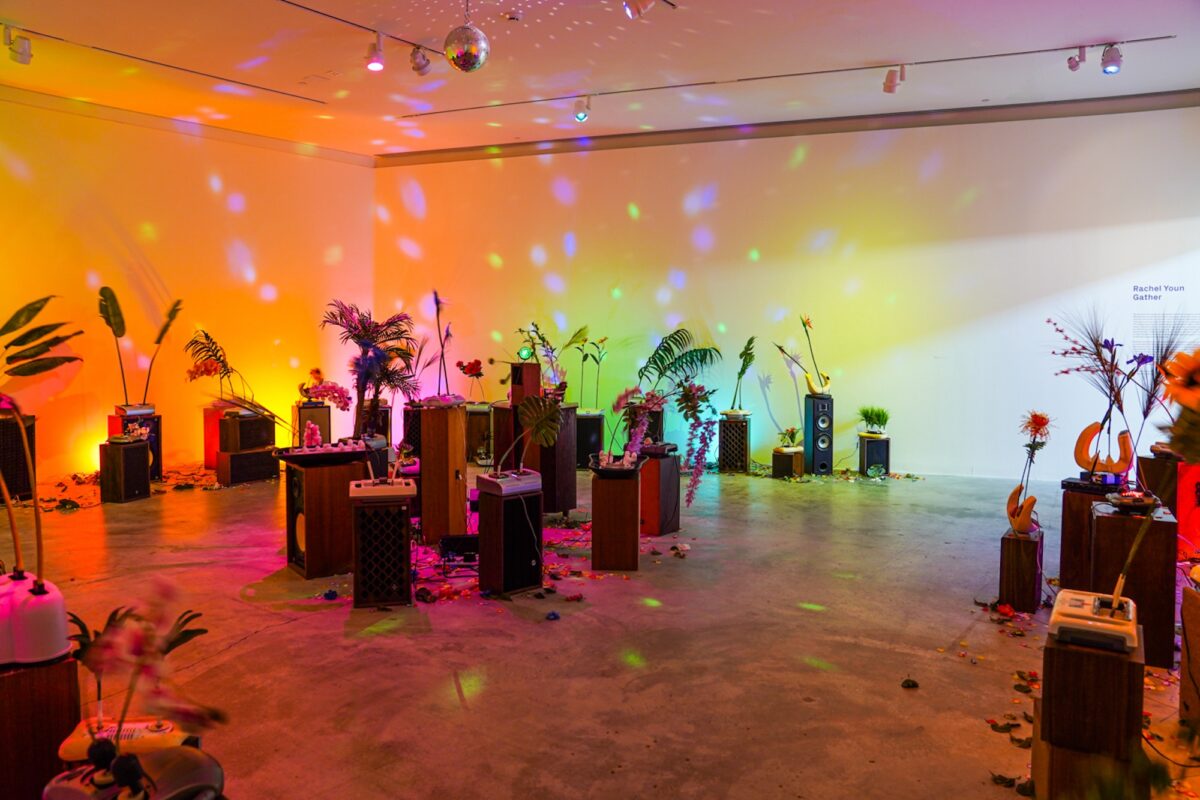
What are your hopes in the future for humans and their technological engagement?
I don’t tend to think about my dream for the future because it’s easy for me to fall into a pessimistic whirlpool, but I’m thinking back to this moment when I had thought about targeted ads as being cute. When you watch cable television, the ads are all over the place, vacations, exercise stuff, restaurants, it feels random. But I also thought about this algorithm showing me an ad for some Home Depot tool as trying to be a genuinely helpful companion, and I hope that our existence with technology can feel innocuous and considerate, rather than manipulative and downright evil, which is where it’s going now.
People have this desire to add stimuli to their environments and I want to enjoy that a lot of these appliances meant to make our daily tasks manageable can be cute or silly just as we are. And so I don’t know. I would like to think that technology could do that. It’s a little bit scary to think about technology as total escapism from the day-to-day. It’s like a double edged sword. We seem to be trying to find ways to become more efficient as a species, but I fear that the free time we gain becomes ripe for more work. Lately I’ve been wishing to have time to be bored and let my mind wander and remember the little things and remember to reach out to friends I haven’t seen in a while. Yes, I could eventually have a machine that folds my laundry so I can be more efficient about something else, but for right now, I cherish that time to use my hands and let my mind slow down.
To learn more about Rachel Youn, follow them on Instagram at @rachelyoun and visit their website at rachelyoun.com.
